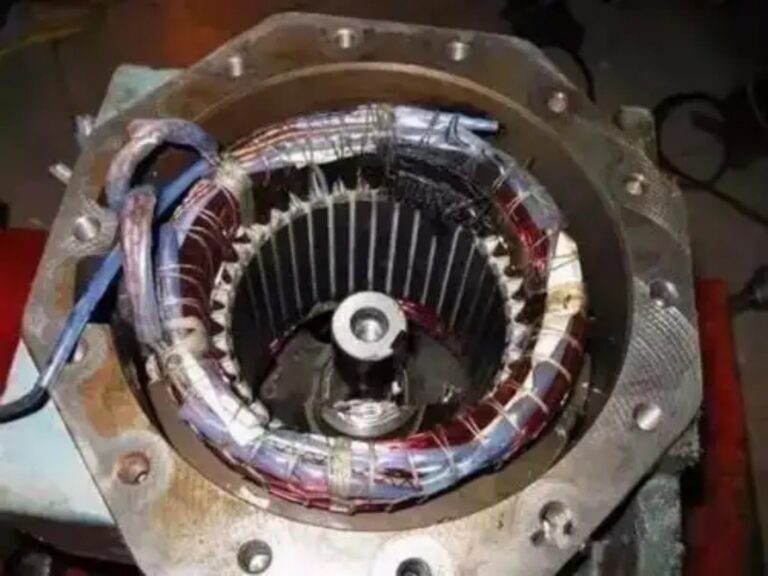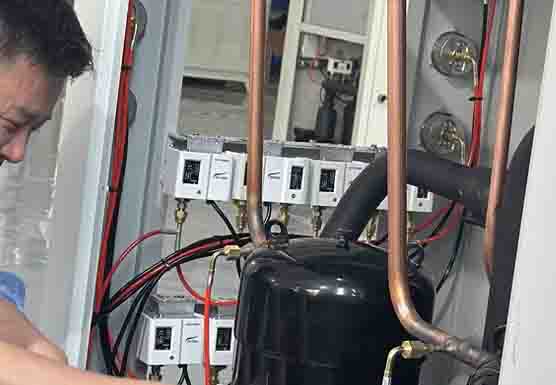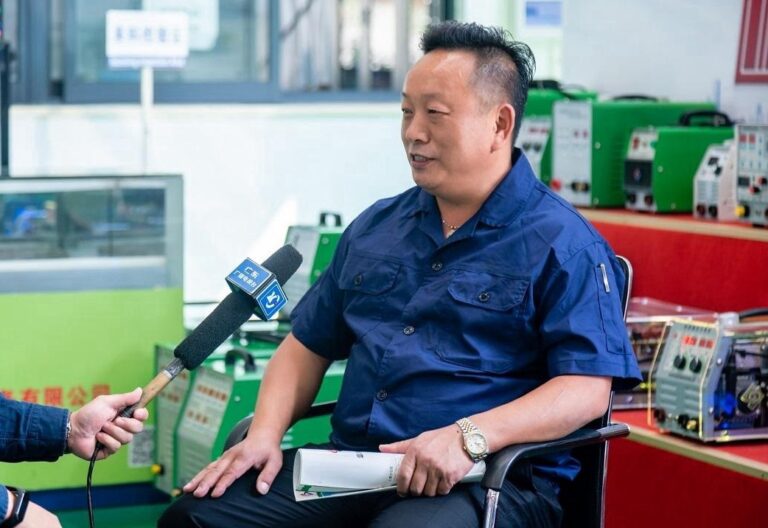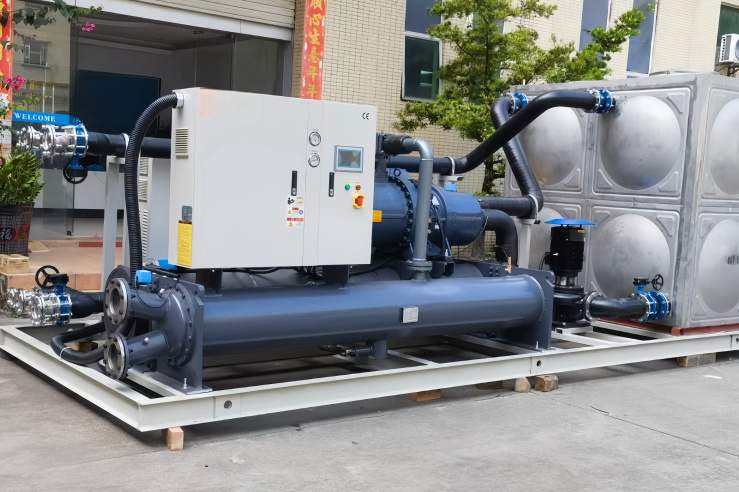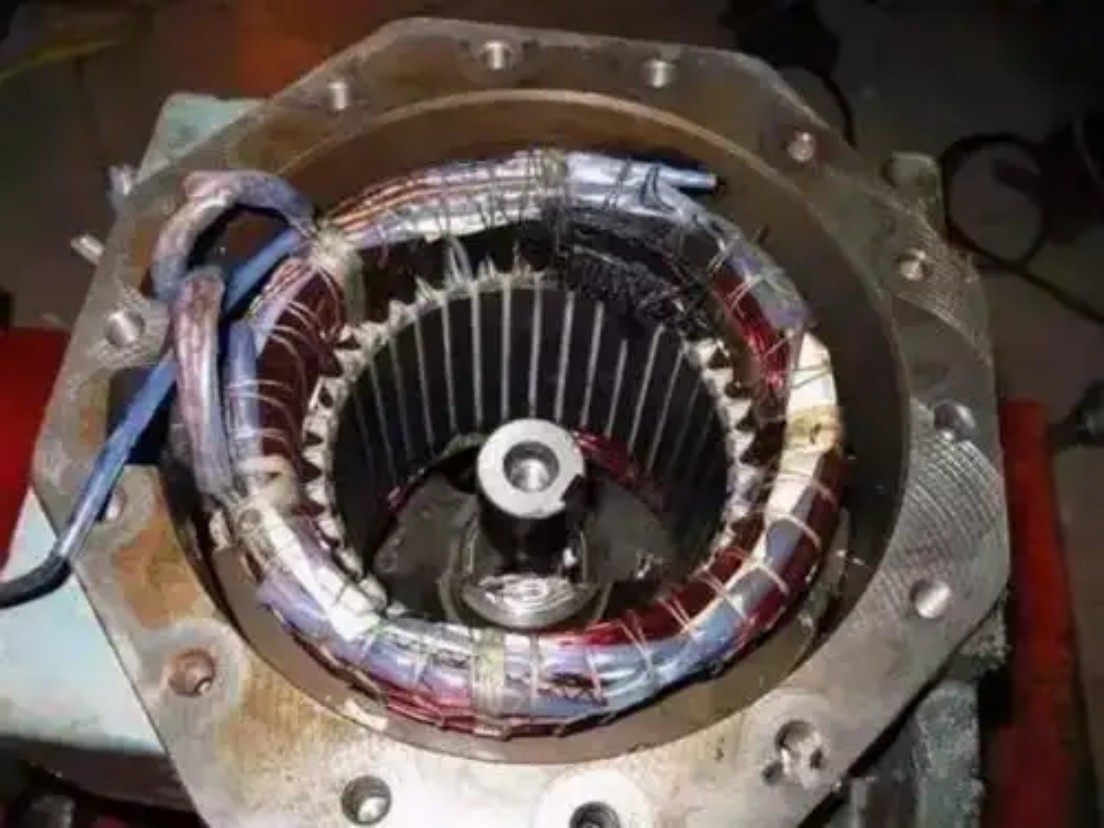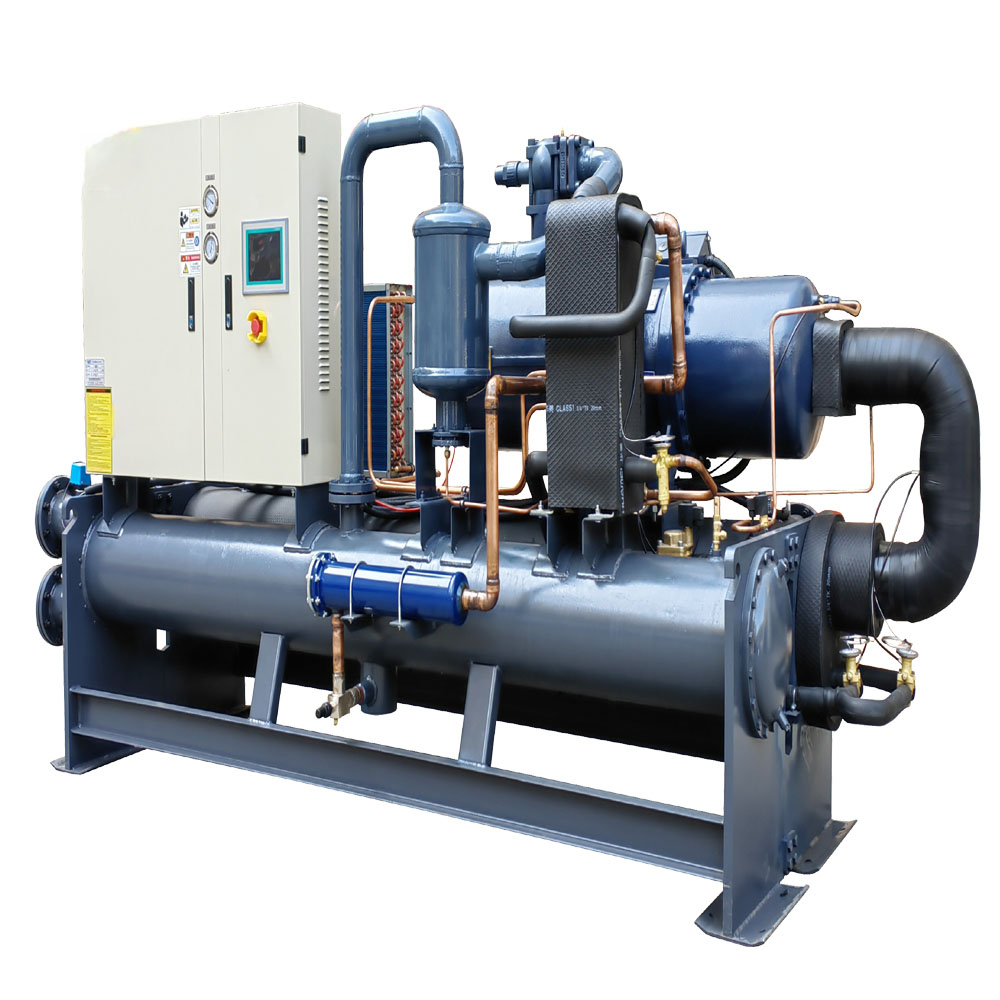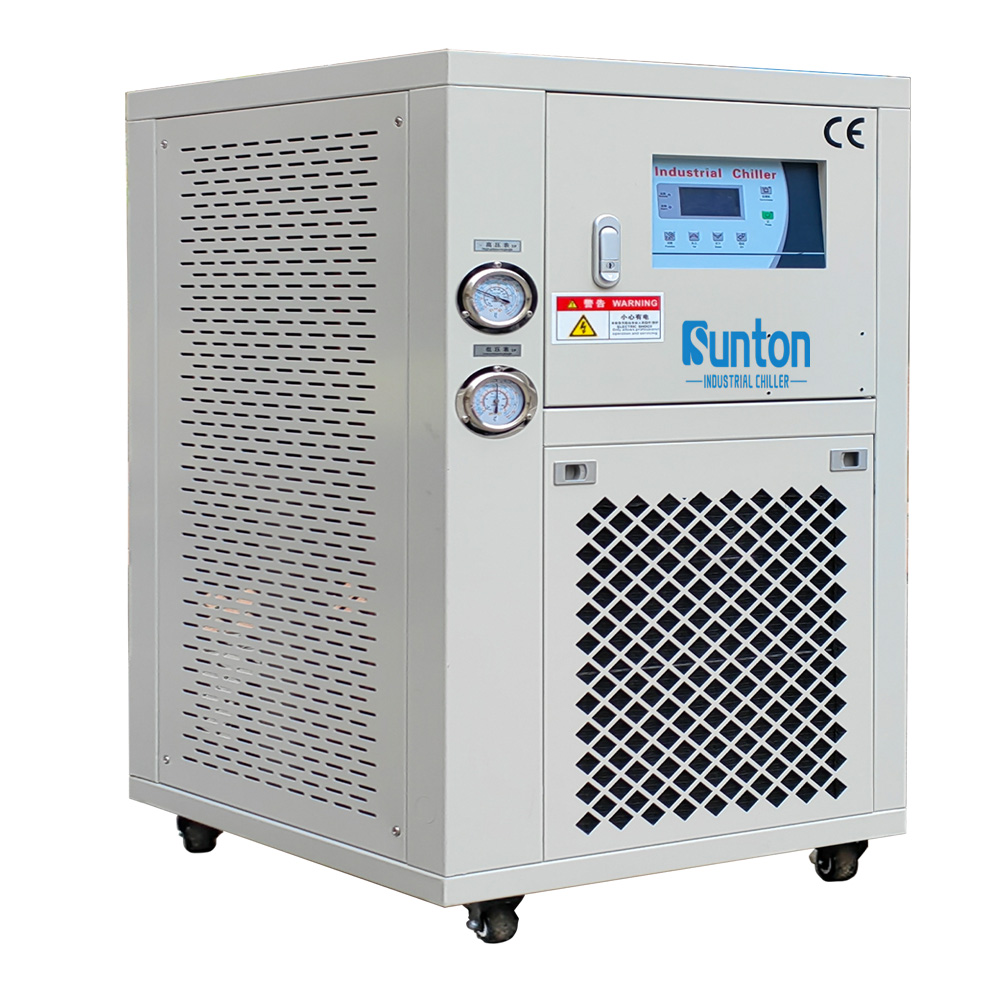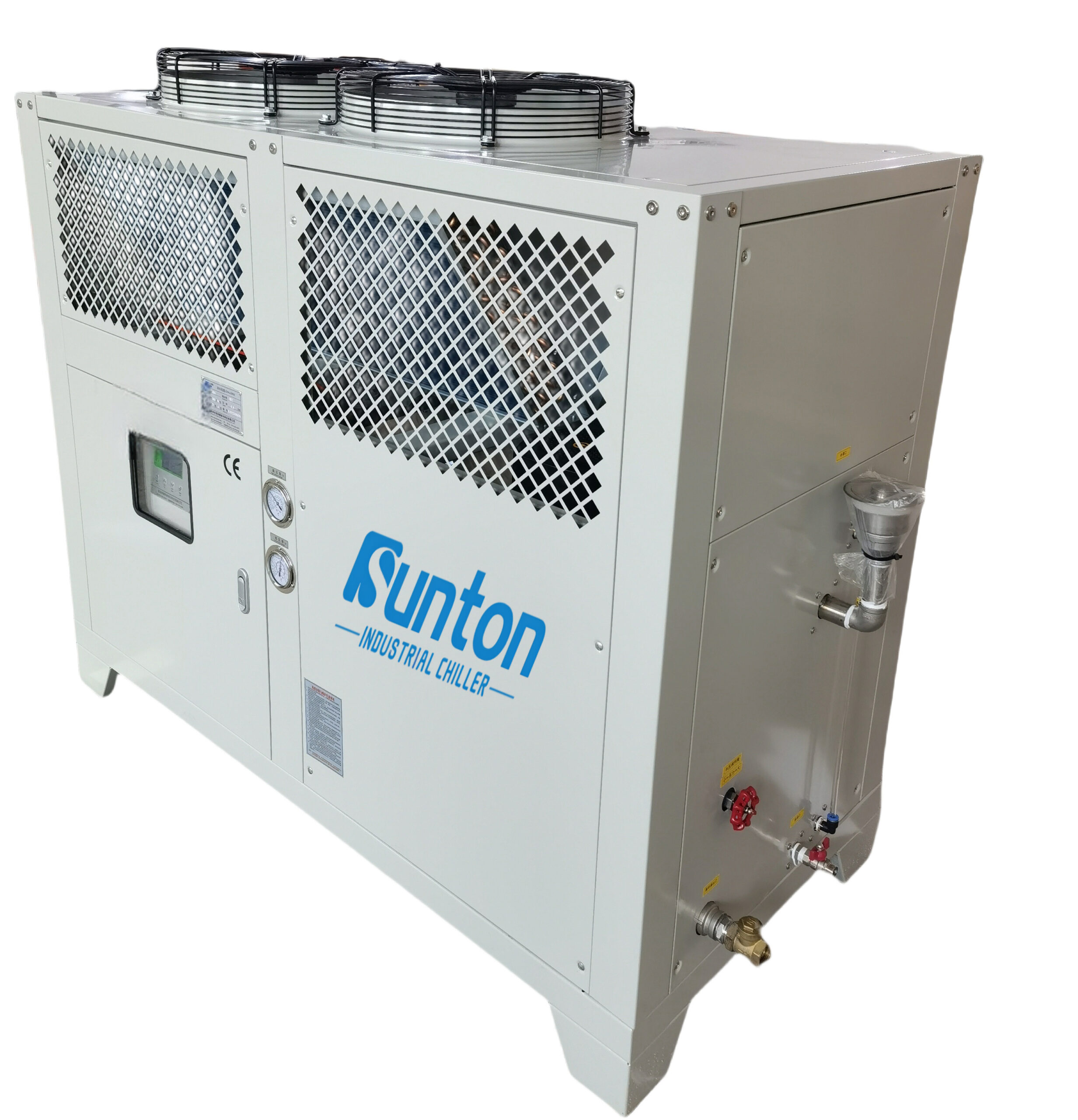-
Dalingshan Industrial Guangdong
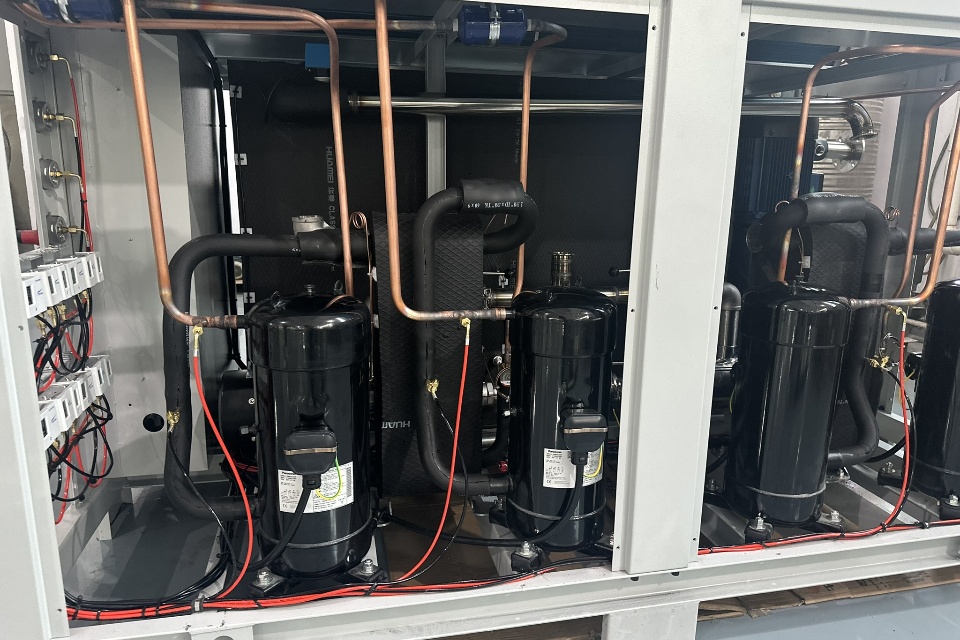
Enfriador de procesos industriales para semiconductores
Desbloqueando la precisión: Los enfriadores de fluidos y los sistemas de calor utilizados en la investigación son cruciales. Rol esencial de los enfriadores en la industria de semiconductores.
Índice
La industria de los semiconductores es la columna vertebral de la tecnología moderna, impulsando desde nuestros teléfonos inteligentes hasta equipos médicos avanzados. Pero ¿sabías que un control preciso de la temperatura es vital para obtener un mayor rendimiento durante los procesos térmicos rápidos? Es absolutamente crucial en la fabricación de semiconductores. Aquí es donde los enfriadores industriales entran en escena, desempeñando un papel vital entre bastidores. En este artículo, exploraremos por qué los enfriadores son indispensables para la industria de los semiconductores, los diferentes tipos disponibles y cómo el enfriador adecuado puede optimizar tu proceso de producción. También analizaremos cómo elegir el enfriador correcto puede aumentar la eficiencia, reducir los costos y, en última instancia, producir semiconductores de mayor calidad. Así que, si te dedicas a la fabricación de semiconductores, ¡esta es una lectura imprescindible!
Esquema del artículo:
- ¿Qué es un enfriador y por qué es crucial para la industria de semiconductores?
- ¿Cómo afectan los enfriadores al proceso de fabricación de semiconductores?
- ¿Cuáles son los requisitos específicos de control de temperatura en la fabricación de semiconductores?
- Tipos de enfriadores utilizados en la fabricación de semiconductores: un análisis profundo
- Cómo elegir el enfriador adecuado para su aplicación de semiconductores: consideraciones clave
- Optimización del rendimiento del enfriador para máxima eficiencia y confiabilidad
- Análisis costo-beneficio: Invertir en el sistema de enfriamiento adecuado
- Tendencias futuras en la tecnología de enfriadores para la industria de semiconductores
- Estudios de caso: Ejemplos reales de aplicaciones de enfriadores en instalaciones de semiconductores
- Mantenimiento y resolución de problemas de enfriadores de semiconductores
¿Qué es un enfriador y por qué es crucial para la industria de semiconductores?
Un enfriador es un sistema de refrigeración que extrae el calor de un proceso o aplicación y lo transfiere a otra parte. Imagine un refrigerador, pero a una escala industrial mucho mayor. En la industria de los semiconductores, un enfriador es absolutamente esencial, ya que el proceso de fabricación es extremadamente sensible a las fluctuaciones de temperatura. Semiconductor Los dispositivos se construyen sobre obleas de materiales como el silicio. El proceso de fabricación de semiconductores implica numerosos pasos, como el grabado, la deposición y la litografía, que generan una cantidad considerable de calor. Si este calor no se gestiona con precisión, puede provocar defectos, una reducción del rendimiento e incluso la falla total del producto. Un enfriador proporciona un control preciso de la temperatura, garantizando que cada paso del proceso se realice en condiciones óptimas. BV Thermal Systems, por ejemplo, se especializa en soluciones rentables para semiconductores y proporciona estos cruciales sistemas térmicos.
Imagine hornear un pastel: si la temperatura del horno no es la adecuada, el pastel no subirá correctamente. De igual manera, en la fabricación de semiconductores, incluso pequeñas variaciones de temperatura pueden tener un gran impacto. Los enfriadores están diseñados para mantener una temperatura estable, garantizando que el proceso de fabricación de semiconductores se desarrolle de forma fluida y eficiente. Este control preciso de la temperatura es vital para lograr altos rendimientos durante el procesamiento térmico rápido. La industria de los semiconductores depende de los enfriadores para eliminar el exceso de calor y mantener la estabilidad de temperatura necesaria.
¿Cómo afectan los enfriadores al proceso de fabricación de semiconductores?
Los enfriadores tienen un profundo impacto en cada etapa del proceso de fabricación de semiconductores. Desde el crecimiento de los cristales de silicio hasta el empaquetado de los chips finales, el control preciso de la temperatura es fundamental. Por ejemplo, durante el rápido procesamiento térmico de las obleas de silicio, los enfriadores ayudan a mantener las temperaturas exactas necesarias para un dopaje y recocido precisos. Sin esta precisión, las propiedades eléctricas del material semiconductor se verían comprometidas. El proceso requiere un entorno de temperatura extremadamente estable. El enfriador lo garantiza.
Además, los enfriadores desempeñan un papel fundamental en la fotolitografía, un paso clave en la fabricación de semiconductores, donde se graban los patrones de circuitos en obleas. El proceso de fabricación de semiconductores es extremadamente sensible a las variaciones de temperatura. Los enfriadores se utilizan para enfriar los equipos y los productos químicos empleados en este proceso, evitando distorsiones y garantizando una transferencia precisa de los patrones. Asimismo, se utilizan enfriadores para enfriar los equipos utilizados en los sistemas de inspección óptica automatizada de semiconductores. Estos sistemas suelen generar un calor considerable, y los enfriadores evitan el sobrecalentamiento y garantizan resultados de inspección precisos. Las instalaciones modernas de semiconductores dependen de enfriadores que proporcionan una regulación precisa de la temperatura, lo que mejora el control de calidad y el rendimiento general de la fabricación durante el procesamiento térmico rápido.
¿Cuáles son los requisitos específicos de control de temperatura en la fabricación de semiconductores?
La industria de semiconductores exige tolerancias de control de temperatura extremadamente estrictas, a menudo de fracciones de grado Celsius. Los requisitos específicos de temperatura varían según la etapa del proceso de fabricación de semiconductores. Por ejemplo, las obleas de silicio para semiconductores pueden requerir un control de temperatura diferente al de los baños químicos utilizados en el grabado. Algunos procesos pueden requerir temperaturas de hasta -80 °C, mientras que otros pueden requerir temperaturas de cientos de grados Celsius. Los enfriadores para metrología de semiconductores deben ser especialmente precisos. El proceso de fabricación de semiconductores es complejo y cada etapa requiere un entorno térmico específico.
La capacidad de refrigeración necesaria para una aplicación determinada depende de diversos factores, como el calor generado por el equipo, la temperatura ambiente y la temperatura de consigna deseada. Los sistemas de semiconductores tienen necesidades específicas, y el enfriador adecuado puede lograr la estabilidad de temperatura necesaria. Estos sistemas suelen funcionar 24/7, por lo que los enfriadores deben ser fiables y capaces de mantener un rendimiento constante durante periodos prolongados. Los enfriadores proporcionan la gestión térmica necesaria para cumplir estos estrictos requisitos. El sistema enfriador en sí mismo debe ser supervisado y mantenido para garantizar su precisión continua.
Tipos de enfriadores utilizados en la fabricación de semiconductores: un análisis profundo
En la industria de semiconductores se utilizan varios tipos de enfriadores, cada uno con sus propias ventajas y desventajas. Los enfriadores de recirculación son comunes y funcionan mediante la circulación continua de refrigerante por el sistema para eliminar el calor. Existen dos categorías principales: enfriadores de fluido refrigerado por recirculación y sistemas de eliminación de calor sin refrigeración.
- Enfriadores refrigerados: Estos enfriadores utilizan un refrigerante para enfriar el refrigerante, ofreciendo una refrigeración precisa y potente. Están disponibles en diversas configuraciones, incluyendo modelos refrigerados por agua y por aire. Enfriador de agua de tornillo refrigerado por agua Se utilizan a menudo para aplicaciones más grandes con altas cargas térmicas.
- Enfriadores termoeléctricos: Estos enfriadores utilizan el efecto Peltier para crear una diferencia de temperatura y eliminar el calor. Los enfriadores termoeléctricos están diseñados para aplicaciones donde el tamaño compacto y el control preciso de la temperatura son esenciales. Refrigeradores antiexplosión Proporcionan un nivel adicional de seguridad en entornos con materiales peligrosos. Son un tipo de enfriador termoeléctrico y son cada vez más populares en la industria de semiconductores debido a su eficiencia y tamaño compacto.
- Enfriadores de inmersión: Estos enfriadores enfrían directamente el fluido del proceso sumergiendo un serpentín o sonda de enfriamiento en él. Se utilizan a menudo en aplicaciones que requieren un enfriamiento rápido o donde el espacio es limitado.
- Enfriadores de proceso:Estos enfriadores están diseñados para procesos industriales específicos, como la fabricación de semiconductores. Enfriador de tornillo refrigerado por aire es un ejemplo que ofrece un rendimiento robusto y confiable.
Cómo elegir el enfriador adecuado para su aplicación de semiconductores: consideraciones clave
Seleccionar el enfriador adecuado es una decisión crucial que puede afectar significativamente la eficiencia, la fiabilidad y la rentabilidad de la fabricación de semiconductores. Se deben considerar varios factores:
- Capacidad de refrigeración: El enfriador debe tener suficiente capacidad de refrigeración para gestionar la carga térmica generada por el proceso. Esta se mide normalmente en kilovatios (kW) o BTU/h. Una capacidad de refrigeración de 400 vatios podría ser suficiente para algunas aplicaciones de metrología, mientras que las instalaciones más grandes pueden requerir enfriadores con decenas o cientos de kilovatios de capacidad. Considere las necesidades de refrigeración actuales y futuras.
- Rango de temperatura y estabilidad: El enfriador debe ser capaz de mantener el rango de temperatura y la estabilidad requeridos para la aplicación específica del semiconductor. Busque enfriadores que proporcionen un control preciso de la temperatura, generalmente dentro de ±0,1 °C o inferior.
- Compatibilidad del refrigerante: El enfriador y sus componentes deben ser compatibles con el refrigerante utilizado en el proceso de fabricación de semiconductores. Algunos procesos pueden requerir refrigerantes especializados para prevenir la corrosión o la contaminación.
- Confiabilidad y mantenimiento: Elija un enfriador de un fabricante reconocido y con un historial comprobado de fiabilidad. Considere la facilidad de mantenimiento y la disponibilidad de repuestos. El tiempo de inactividad puede ser extremadamente costoso en la fabricación de semiconductores.
- Costo de propiedad: Evalúe el costo total de propiedad de los equipos semiconductores, incluyendo el precio de compra inicial, los costos de instalación, los gastos operativos y los costos de mantenimiento. Los enfriadores de recirculación son una mejor opción a largo plazo si necesita ahorrar dinero.
- Requisitos de espacio y huella: Asegúrese de que el enfriador quepa en el espacio disponible de la instalación. Los enfriadores de recirculación termoeléctricos ocupan menos espacio que los sistemas de mayor tamaño basados en compresores.
Optimización del rendimiento del enfriador para máxima eficiencia y confiabilidad
Una vez seleccionado el enfriador adecuado, es crucial optimizar su rendimiento para lograr la máxima eficiencia y fiabilidad. A continuación, se presentan algunas estrategias clave:
- Instalación y configuración adecuadas: Asegúrese de que el enfriador esté correctamente instalado y de que todas las conexiones estén selladas correctamente. Siga las instrucciones del fabricante para la instalación y la puesta en marcha.
- Mantenimiento regular: Implemente un programa de mantenimiento preventivo que incluya inspecciones, limpieza y mantenimiento regulares del enfriador y sus componentes. Esto puede ayudar a prevenir averías inesperadas y prolongar la vida útil del equipo. Los enfriadores están diseñados para durar mucho tiempo, pero solo lo harán con el mantenimiento adecuado. Sistemas antiguos basados en compresores. Los semiconductores más antiguos podrían requerir más atención que los nuevos y más avanzados.
- Gestión del refrigerante: Supervise los sistemas de refrigeración líquida ambiental para garantizar un rendimiento óptimo. Revise periódicamente el nivel y la calidad del refrigerante. Reemplace el refrigerante según sea necesario para mantener su eficacia y prevenir la corrosión. Se recomienda usar una mezcla para prevenir la proliferación de microorganismos en el sistema.
- Equilibrio de carga: Distribuya la carga de refrigeración uniformemente entre varios enfriadores, si es posible. Esto puede mejorar la eficiencia y reducir el desgaste de las unidades individuales. La carga térmica cambia constantemente, por lo que se necesitan controles inteligentes.
- Medidas de eficiencia energética: Implemente prácticas de eficiencia energética, como la optimización de los parámetros operativos y el uso de variadores de velocidad para bombas y ventiladores. Los enfriadores modernos suelen contar con funciones avanzadas de ahorro de energía. Por ejemplo, la tecnología termoeléctrica de estado sólido reduce el consumo de energía, lo que se traduce en menores costos operativos.
- Monitoreo y análisis de datos: Utilice sistemas de monitoreo de enfriadores para monitorear datos de rendimiento, como temperatura, presión y consumo de energía. Estos datos pueden utilizarse para identificar posibles problemas y optimizar los parámetros operativos. Los sistemas de refrigeración modernos incluyen sensores avanzados y herramientas de diagnóstico.
Análisis costo-beneficio: Invertir en el sistema de enfriamiento adecuado
Invertir en un sistema de refrigeración de alta calidad supone un gasto inicial considerable, pero puede generar importantes beneficios a largo plazo. Un sistema de refrigeración bien diseñado y mantenido puede:
- Mejorar la calidad del producto: Un control preciso de la temperatura permite un mayor rendimiento durante el procesamiento térmico rápido y menos defectos, lo que resulta en dispositivos semiconductores de mayor calidad. Esto se traduce en una mayor satisfacción del cliente y precios de venta más altos.
- Aumente la eficiencia de la producción: Los enfriadores confiables minimizan el tiempo de inactividad y garantizan que el proceso de fabricación de semiconductores se desarrolle de forma fluida y eficiente. Esto se traduce en un mayor rendimiento y una reducción de los costos de producción.
- Reducir el consumo de energía: Los enfriadores energéticamente eficientes pueden reducir significativamente los costos operativos, especialmente en instalaciones con alta demanda de refrigeración. Los enfriadores modernos suelen incorporar características como variadores de velocidad y algoritmos de control avanzados para optimizar el consumo de energía. Algunos sistemas modernos basados en compresores son mucho más eficientes que las versiones anteriores.
- Prolongar la vida útil del equipo: Un control adecuado de la temperatura puede prolongar la vida útil de los equipos de fabricación de semiconductores, reduciendo la necesidad de costosos reemplazos. El propio enfriador, con un mantenimiento adecuado, también tendrá una vida útil más larga.
- Mejorar la seguridad: Los enfriadores confiables pueden prevenir el sobrecalentamiento y otros riesgos de seguridad, protegiendo tanto al personal como al equipo. Aprobado por UL para uso en laboratorios industriales, algunos enfriadores ofrecen características de seguridad garantizadas.
Un análisis exhaustivo de costo-beneficio debe considerar todos estos factores para determinar la inversión óptima en un sistema de enfriado. Si bien un precio inicial más bajo puede parecer atractivo, un enfriador de mayor calidad y eficiencia suele ofrecer una mejor rentabilidad a lo largo de su vida útil.
Tendencias futuras en la tecnología de enfriadores para la industria de semiconductores
La industria de los semiconductores está en constante evolución, y la tecnología de enfriadores se mantiene al día. Diversas tendencias están configurando el futuro de los enfriadores para aplicaciones de semiconductores:
- Mayor eficiencia energética: A medida que los costos de la energía siguen aumentando y la preocupación por el medio ambiente crece, se hace un gran hincapié en el desarrollo de enfriadores más eficientes energéticamente. Esto incluye el uso de refrigerantes avanzados, variadores de velocidad y sofisticados algoritmos de control. La tecnología termoeléctrica reduce el número de piezas móviles, lo que se traduce en un menor consumo de energía.
- Huella más pequeña: El espacio suele ser limitado en las instalaciones de fabricación de semiconductores, por lo que existe una demanda de enfriadores más compactos. Los enfriadores termoeléctricos ofrecen una ventaja significativa en este sentido.
- Control de temperatura y estabilidad mejorados: A medida que los dispositivos semiconductores se vuelven más complejos y requieren tolerancias de control de temperatura más estrictas, se diseñan enfriadores para proporcionar mayor precisión y estabilidad. Los enfriadores modernos utilizan sensores avanzados y sistemas de control de retroalimentación para mantener valores de ajuste de temperatura precisos. Una mayor estabilidad y protección térmica para equipos sensibles es un objetivo clave.
- Enfriadores inteligentes e integración de IoT: Los enfriadores son cada vez más inteligentes, con sensores, microprocesadores y capacidades de comunicación integrados. Esto permite la monitorización, el diagnóstico y el control remotos, así como la integración con otros sistemas de fabricación de semiconductores mediante el Internet de las Cosas (IoT).
- Uso de refrigerantes alternativos: Debido a la preocupación ambiental por los refrigerantes tradicionales, existe una tendencia creciente hacia el uso de refrigerantes alternativos con menor potencial de calentamiento global (PCG). Estos incluyen refrigerantes naturales como el CO₂ y el amoníaco, así como refrigerantes sintéticos con mejores perfiles ambientales. Algunas instalaciones están intentando eliminar por completo el uso de refrigerantes nocivos.
- Sistemas avanzados de gestión térmica: Los enfriadores del futuro se integrarán en sistemas de gestión térmica más completos que optimizan la refrigeración en toda la planta de fabricación de semiconductores. Esto implicará el uso de sensores avanzados, análisis de datos y estrategias de control sofisticadas. Las crecientes exigencias de la gestión térmica de las instalaciones de semiconductores impulsan estas innovaciones. Esto implica sistemas que se ajustan en tiempo real a las cargas térmicas dinámicas del proceso de fabricación de semiconductores.

Estudios de caso: Ejemplos reales de aplicaciones de enfriadores en instalaciones de semiconductores
Veamos algunos ejemplos específicos de cómo se utilizan los enfriadores en instalaciones de fabricación de semiconductores del mundo real:
Estudio de caso 1: Un enfriador líder para semiconductores podría mejorar la eficiencia. Un fabricante de semiconductores experimentaba problemas de rendimiento debido a las fluctuaciones de temperatura durante el rápido procesamiento térmico de obleas de silicio. Implementaron un nuevo sistema de enfriador con capacidades mejoradas de control de temperatura, lo que resultó en un aumento del rendimiento de 5% y una reducción significativa de los desechos. Los nuevos enfriadores proporcionaron temperaturas estables con un margen de error de +/- 0,05 °C.
Estudio de caso 2: Una planta de fabricación de semiconductores tenía dificultades para afrontar los altos costos energéticos asociados con su antiguo sistema de enfriadores. Reemplazaron los enfriadores antiguos por modelos modernos y de bajo consumo, lo que resultó en una reducción del consumo energético y un ahorro significativo de costos. Los nuevos enfriadores también ocupaban menos espacio, liberando valioso espacio en las instalaciones. Enfriadora de agua scroll refrigerada por aire Fue elegido por su tamaño más reducido.
Estudio de caso 3: Una empresa de semiconductores desarrollaba nuevos sistemas de metrología automatizados que utilizaban láseres. Estos sistemas requieren un control de temperatura de alta precisión para mantener la exactitud de las mediciones láser. Implementaron un enfriador termoeléctrico de alto rendimiento y gran estabilidad de temperatura, lo que les permitió alcanzar la precisión de medición requerida. El enfriador proporcionaba 400 vatios de capacidad de refrigeración, manteniendo una estabilidad de temperatura de ±0,01 °C.
Estudio de caso 4: Para mejorar el rendimiento durante el procesamiento térmico rápido, una empresa de semiconductores recurrió a soluciones térmicas más avanzadas. Modernizaron sus instalaciones con enfriadores que proporcionan un control preciso de la temperatura, crucial para el delicado proceso de procesamiento térmico de obleas de silicio. Esto no solo resultó en un mayor rendimiento, sino también en una reducción del estrés térmico en los equipos, prolongando su vida útil y contribuyendo a un proceso de fabricación más sostenible. La mayor estabilidad de la temperatura también tuvo un impacto positivo en la calidad del producto, permitiéndoles cumplir con las exigentes especificaciones de sus clientes en sectores como el aeroespacial y las telecomunicaciones. Soluciones de refrigeración a baja temperatura | Advanced Chill Technologies Les dio la precisión necesaria.
Caso práctico 5Una empresa importante en la industria de semiconductores se enfrentaba a desafíos relacionados con el costo de propiedad de los equipos de inspección óptica automatizada de semiconductores. La refrigeración puntual de los sistemas de inspección metrológica resultaba costosa con su configuración actual, que dependía de ventiladores o refrigeración líquida ambiental. Decidieron implementar enfriadores de recirculación termoeléctricos, necesarios para la refrigeración puntual y con un consumo energético mucho más eficiente. Este cambio supuso una reducción significativa de los costos operativos y mejoró la fiabilidad del proceso de inspección. Además, esta decisión contribuyó a una mayor estabilidad en la gestión térmica de los sistemas de inspección óptica automatizada de semiconductores. Dado que los enfriadores termoeléctricos están diseñados para un control preciso de la temperatura, los sistemas de inspección ahora funcionaban a temperaturas óptimas de forma constante, lo que mejoraba la calidad de la inspección y minimizaba la necesidad de recalibración, reduciendo aún más el tiempo de inactividad y el costo de propiedad de los sistemas ópticos automatizada de semiconductores. Enfriador de agua Scroll refrigerado por agua Ofrecemos una solución versátil para tales necesidades.
Estos estudios de caso demuestran el papel fundamental que desempeñan los enfriadores en la optimización
64.3 s flecha_arribaflecha_abajoeditarmás_vert
continuar flecha_arribaflecha_abajoeditarmás_vert
Procesos de fabricación de semiconductores, mejorando la calidad del producto, aumentando la eficiencia y reduciendo costos.
Mantenimiento y resolución de problemas de enfriadores de semiconductores
Un mantenimiento adecuado es esencial para garantizar el funcionamiento fiable y eficiente de los enfriadores de semiconductores. Un programa de mantenimiento proactivo puede prevenir averías inesperadas, prolongar la vida útil del equipo y minimizar el tiempo de inactividad. Las tareas clave de mantenimiento incluyen:
- Inspecciones periódicas: Inspeccione regularmente el sistema de refrigeración para detectar fugas, corrosión y otros signos de desgaste. Compruebe los niveles, presiones y temperaturas del refrigerante.
- Limpieza: Limpie regularmente los serpentines del condensador, del evaporador y de los filtros para garantizar una transferencia de calor óptima. Los serpentines sucios pueden reducir significativamente la eficiencia del enfriador.
- Análisis y tratamiento de refrigerante: Analice periódicamente el refrigerante para garantizar que cumpla con las especificaciones. Trate el refrigerante según sea necesario para prevenir la corrosión y el desarrollo biológico.
- Lubricación: Lubrique las bombas, ventiladores y otras piezas móviles de acuerdo con las recomendaciones del fabricante.
- Calibración: Calibre periódicamente los sensores de temperatura y los sistemas de control para garantizar un control preciso de la temperatura. El control de la temperatura en los procesos de semiconductores depende en gran medida de la precisión de estos sensores.
- Monitoreo del rendimiento: Monitoree los datos de rendimiento del enfriador, como la temperatura, la presión y el consumo de energía, para identificar posibles problemas de forma temprana. Estos datos pueden utilizarse para optimizar los parámetros operativos y prevenir fallos.
- Mantenimiento de registros: Mantener registros detallados de todas las actividades de mantenimiento, incluidas inspecciones, reparaciones y cambios de refrigerante.
A pesar del mantenimiento regular, los enfriadores pueden presentar problemas ocasionalmente. Los pasos comunes para solucionarlos incluyen:
- Comprobar alarmas y códigos de error: La mayoría de los enfriadores modernos cuentan con sistemas de diagnóstico integrados que muestran alarmas y códigos de error. Consulte el manual del enfriador para interpretar estos códigos e identificar el origen del problema.
- Inspeccionar las conexiones eléctricas: Verifique si hay conexiones eléctricas sueltas o corroídas, ya que pueden provocar fallas en el enfriador.
- Verificar el flujo de refrigerante: Asegúrese de que haya un flujo adecuado de refrigerante en el sistema. Un flujo bajo puede provocar sobrecalentamiento y reducir la capacidad de refrigeración.
- Comprobar la carga de refrigerante: Si el enfriador utiliza refrigerante, verifique que la carga de refrigerante sea correcta. Una carga baja de refrigerante puede indicar una fuga.
- Inspeccionar el compresor: El compresor es un componente esencial de muchos enfriadores. Inspeccione el compresor para detectar signos de desgaste o daños.
Si los pasos de solución de problemas no dan resultado, lo mejor es contactar a un técnico de servicio de enfriadores cualificado. Los enfriadores son una mejor opción cuando funcionan correctamente, pero requieren especialistas capacitados para problemas complejos.
Preguntas frecuentes:
¿Por qué es tan crítico el control de temperatura en la industria de los semiconductores?
El control de temperatura es crucial, ya que el proceso de fabricación de semiconductores implica materiales y procesos extremadamente sensibles. Incluso pequeñas variaciones de temperatura pueden provocar defectos, reducción del rendimiento y fallos del producto. La producción de dispositivos semiconductores requiere un entorno térmico extremadamente estable.
¿Cuáles son las ventajas de utilizar enfriadores termoeléctricos en la fabricación de semiconductores?
Los enfriadores termoeléctricos ofrecen varias ventajas, como su tamaño compacto, un control preciso de la temperatura, alta fiabilidad y bajo nivel de ruido. Además, son respetuosos con el medio ambiente, ya que no utilizan refrigerantes con alto potencial de calentamiento global. Además, los enfriadores de recirculación termoeléctricos son especialmente eficaces para aplicaciones de refrigeración localizada. También son ideales para refrigerar equipos de metrología de semiconductores.
¿Cómo puedo determinar la capacidad de enfriamiento adecuada para mi aplicación de semiconductores?
La capacidad de refrigeración necesaria depende de varios factores, como el calor generado por el equipo, la temperatura ambiente y la temperatura de consigna deseada. Se debe realizar un cálculo de la carga térmica para determinar la capacidad de refrigeración requerida. Recuerde tener en cuenta la carga térmica de todo el sistema. En general, los enfriadores de recirculación son una mejor opción para gestionar aplicaciones industriales exigentes y los enfriadores de aire son una mejor opción para una gestión térmica precisa.
¿Cuáles son algunas tareas de mantenimiento comunes para enfriadores de semiconductores?
Las tareas habituales de mantenimiento incluyen inspecciones periódicas, limpieza, análisis y tratamiento del refrigerante, lubricación, calibración, supervisión del rendimiento y mantenimiento de registros. Los enfriadores de proceso suelen requerir cuidados y mantenimiento especializados.
¿Cómo puedo mejorar la eficiencia energética de mi sistema enfriador de semiconductores?
La eficiencia energética se puede mejorar mediante una instalación y configuración adecuadas, mantenimiento regular, gestión del refrigerante, equilibrio de carga, prácticas de eficiencia energética, y monitoreo y análisis de datos. Los enfriadores modernos suelen incluir funciones avanzadas de ahorro de energía. Considere actualizar a sistemas más modernos con compresores para una mayor eficiencia.
¿Cuáles son las últimas tendencias en tecnología de enfriadores para la industria de semiconductores?
Las últimas tendencias incluyen mayor eficiencia energética, menor tamaño, mejor control y estabilidad de la temperatura, enfriadores inteligentes e integración del IoT, y el uso de refrigerantes alternativos. Estos avances buscan satisfacer las necesidades cambiantes de la industria de semiconductores. La complejidad de la fabricación de semiconductores exige una innovación constante en soluciones de refrigeración.
- El control preciso de la temperatura no es negociableLos enfriadores son esenciales para mantener las tolerancias de temperatura extremadamente estrictas requeridas en la fabricación de semiconductores. Incluso pequeñas desviaciones pueden provocar importantes problemas de calidad y pérdidas de rendimiento.
- Los enfriadores impactan cada etapa de la producciónDesde el crecimiento de los cristales de silicio hasta el empaquetado final del chip, los enfriadores desempeñan un papel vital para garantizar un entorno térmico estable y controlado.
- Seleccionar el enfriador adecuado es crucialSe deben considerar cuidadosamente factores como la capacidad de enfriamiento, la estabilidad de la temperatura, la compatibilidad del refrigerante, la confiabilidad, el costo de propiedad y el espacio ocupado.
- La optimización y el mantenimiento son clave:El mantenimiento regular, la instalación adecuada y las prácticas de eficiencia energética pueden maximizar el rendimiento del enfriador, reducir costos y extender la vida útil del equipo.
- La tecnología está avanzando:El futuro de los enfriadores para la industria de semiconductores incluye una mayor eficiencia energética, espacios más pequeños, controles más inteligentes y el uso de refrigerantes alternativos.
- Invertir en el enfriador adecuado vale la penaSi bien la inversión inicial puede ser considerable, un sistema de enfriado de alta calidad puede mejorar la calidad del producto, aumentar la eficiencia, reducir el consumo de energía y obtener mejores resultados. Seleccionar y mantener el enfriador adecuado para aplicaciones de semiconductores es esencial para el éxito en esta exigente industria.
En conclusión:
Al comprender la función crucial de los enfriadores, los diversos tipos disponibles y las mejores prácticas para su selección, operación y mantenimiento, los fabricantes de semiconductores pueden garantizar que sus procesos de producción se desarrollen de forma fluida, eficiente y rentable. Para todas sus necesidades de enfriadores industriales, no busque más: un proveedor confiable y experimentado especializado en sistemas térmicos para la fabricación de semiconductores es la solución. BV Thermal Systems, por ejemplo, cuenta con una amplia experiencia en el suministro de soluciones térmicas para el sector de los semiconductores y cuenta con... Enfriadoras centrales de tornillo refrigeradas por aireSi sus operaciones utilizan láseres como fuente de calor en la fabricación o las pruebas, un enfriador de alta precisión es imprescindible. No olvide explorar Enfriadoras centrales de tornillo refrigeradas por agua Opciones también para lograr una gestión precisa de la temperatura.

